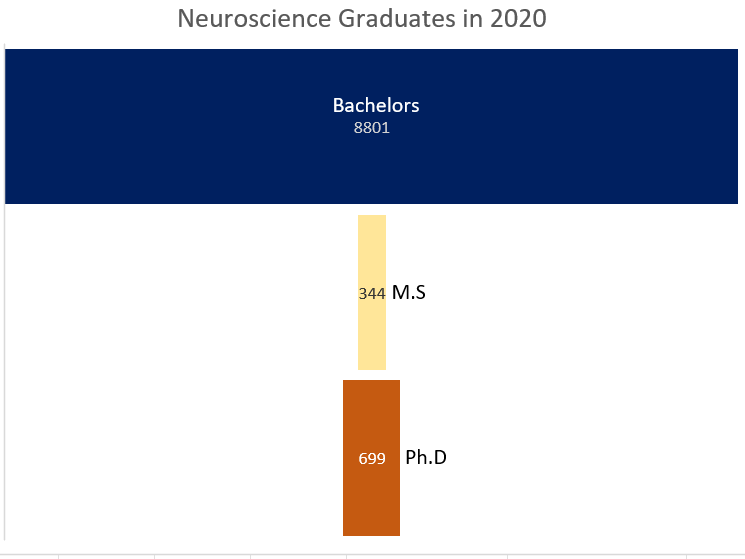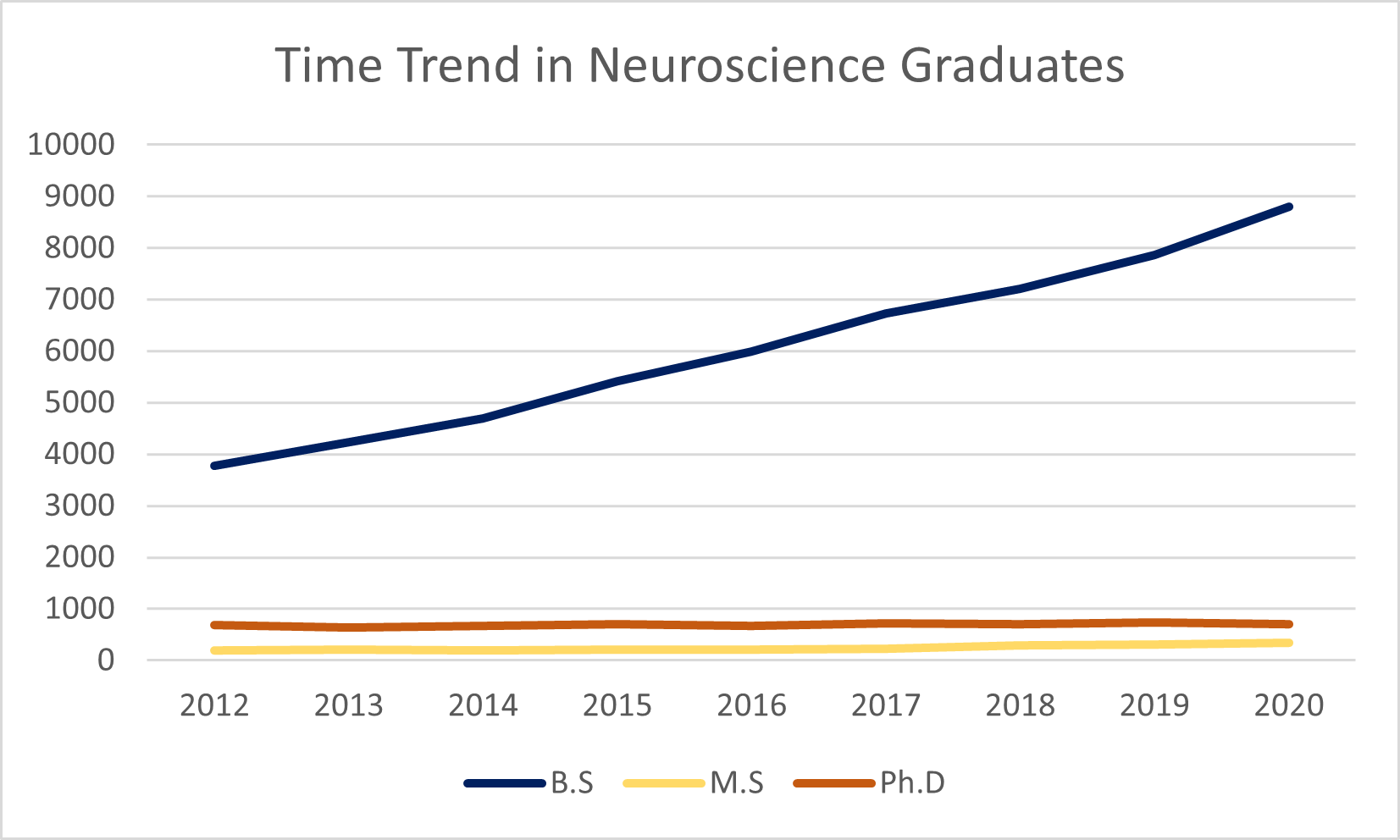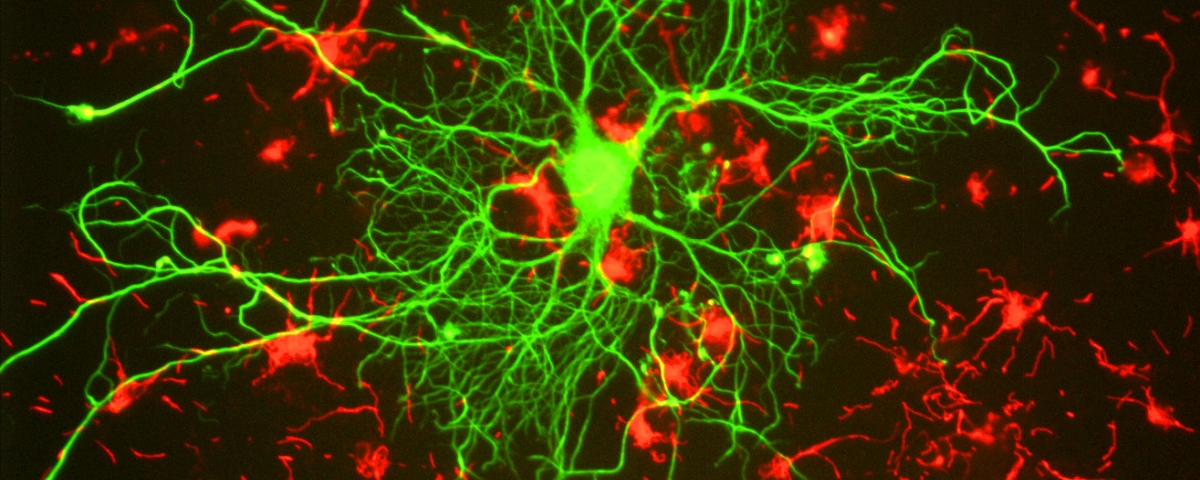Given this increased interest in neuroscience, we thought it would be good to do deep dive into the subejct starting with "What is neuroscience?" and then going into studying neuroscience in college, and career opportunities after a Bachelors and a Doctoral degree in neuroscience.
What is neuroscience?
Neuroscience is the study of the brain. The Department of Education defines it as: A program that focuses on the interdisciplinary scientific study of the molecular, structural, physiologic, cognitive, and behavioral aspects of the brain and nervous system. Includes instruction in molecular and cellular neuroscience, brain science, anatomy and physiology of the central nervous system, molecular and biochemical bases of information processing, behavioral neuroscience, biology of neuropsychiatric disorders, and applications to the clinical sciences and biomedical engineering.
Neuroscience is a very vast subject that can span along the following tracks:
- Cellular and Molecular Neuroscience
- Systems Neuroscience
- Behavioral Neuroscience
- Cognitive Neuroscience
- Computational Neuroscience
Depending on the focus of the research groups, neuroscience can be hands on lab work, observational or computational. It is important to understand the research being conducted as the neuroscience electives and work experience could be closer to basic sciences or more applied like an engineering discipline.
Neuroscience Tracks:
Cellular and Molecular Neuroscience: It is the study of the nervous system and the functioning at a molecular and cellular level. There is a lot of focus on the building blocks such as proteins, ions, electrical and chemical communication between neurons, molecular basis of the impact of genes on the nervous system and its disorders, biochemical interactions in the brain and drugs, understanding neural functions such as sight, sound, taste, feelings at a cellular level. It is very interdisciplinary with molecular and cell biology, physics, chemistry, genetics, anatomy, and pharmacology (study of medicine).
Systems Neuroscience: It deals with the study of how neurons code, communicate, and process the information. Students will learn about sensory processing, reaction of neurons to various stimuli, neural circuitry and pathways and the effect of drugs and chemicals on the pathways. The topics can overlap with behavioral, cognitive and computational neuroscience, electrical engineering, artificial intelligence, biomedical engineering.
Behavioral Neuroscience: It is the study of psychological process from a behavioral perspective. It is interdisciplanry with psychology, biology, chemistry and pharmacology. Students learn about decision making, emotional processes, pathways for learning and memory and normal and abnormal behavior processes.
Cognitive Neuroscience: It is the study of how cognitive functions such as sight, speech, hearing, movement, social interactions are recognized and implemented by the brain and the nervous system. Students also study the effect of impairment on these functions due to diseases, injury or other processes. There is a fair degree of overlap with linguistics, psychology, healthcare.
Computational Neuroscience: It is the study of brain function using mathematical tools, simulations and algorithms. Students learn about neural networks, statistical modeling of neural process, neural dynamics, development of machine learning systems that can mimic the brain. There can be a fair degree of overlap with computer science, statistics, electrical engineering and math.
It is important to note that most of the neuroscience tracks have co dependencies and overlaps with each other. Take a look at UC San Diego resource page which has a comprehensive list of the various courses that can be taken to cover most of these topics.
Neuroscience Undergraduate Major in College:
Most undergrad neuroscience programs in college have two aspects to it:
- The required and elective course work needed in neuroscience
- Research areas offered at the college
Usually the required and elective coursework is (should be) fairly similar across must undergraduate neuroscience programs and consists of at least one course in:
- General Chemistry
- Organic Chemistry
- Biology
- Physics
- Calculus
- Psychology
- Introductory Neuroscience Courses in different concentrations: Cellular/Molecular, System/Behavioral and Cognitive/Computational concentrations in Neuroscience
- Anatomy/Neuroanatomy
- Statistics or Data Analysis
- General Education Requirements (Breadth Requirements)
Here are some sample course plans from Georgia Tech, University of Pennsylvania, University of Texas, UCLA , and Johns Hopkins University .
Most undergraduate programs require their students to have some lab experience and either a seminar or a capstone project in one of the neuroscience concentrations. Students should look into the concentrations and research groups at the colleges that they are interested in applying and attending. This is especially pertinent if the students are interested in pursuing a graduate degree in neuroscience. It is often challenging for most high school students to know a lot about the various neuroscience concentrations as neuroscience is not taught at most high schools.
What should high school students do?
- Students can go to a college which has a wide array of the various neuroscience disciplines offered at undergraduate level where they can pick and choose their concentration/area of interest.
- Students can also research the various concentrations and pick colleges based on their choice. This is a more high value and high risk approach as it allows them to be very focused on their college search, showcase their interest and yet it may not allow for diverse options if the student’s interest changes.
- Students can also do a more general undergraduate degree and pursue their neuroscience concentration of choice in graduate school.
Since many graduate programs like to see some research in a relevant area, a student needs to be mindful of that while looking at undergraduate research offerings. Since many more students study neuroscience in a bachelor’s program as compared to a graduate program, it is important for students to understand the various career pathways after a degree in neuroscience.
Career Pathways after a Bachelor’s degree in Neuroscience
Students who complete an undergraduate degree in neuroscience can follow a number of different paths on graduation.
Biology Related Entry level Jobs:
Most neuroscience graduates will get an entry level position as a lab technician or at best a research assistant job if the students have a significant research or lab experience. The bar to entry in biology related is quite high and due to liability reasons, most jobs in biology related fields are for students with a masters or a doctoral degree.
Non-Biology and Biology Adjacent Entry Level Jobs:
A bachelor’s degree in neuroscience is on par with a bachelor’s in most majors. Graduates can work in product management, sales, marketing, teaching, human resources, public health, regulatory affairs, entry level data analyst, user experience, design related jobs, etc. This is where understanding the various tracks in neuroscience can be of help, as students get experience and skills that can relate to different jobs.
Some of these jobs need an additional qualification or credentialing in addition to the bachelors degree. Students interested in teaching will need to get a teacher’s credential. To work in regulatory affairs, students may need either work experience in regulatory side of pharmaceuticals/biotech. It might also be a good idea for students to take classes in business, marketing, statistics, programming or writing if they are looking to pursue biology adjacent or non biology related jobs.
Medical School
To practice neuroscience clinically or to become a neurosurgeon or a doctor in any other specialization, students need to go to medical school and get their M.D and complete their residency in the relevant field. Many neuroscience students gravitate towards becoming a doctor.
Dental School
Many neuroscience graduates go to dental school to get their DDS or DDMD.
Pharmaceuticals
Pharma companies employ a large number of biology and biological sciences graduatee. Students often get an advancea masters or a Ph.D in chemistry, biochemistry, neuroscience, or in pharmaceutical sciences to work in research or R&D positions at pharma companies.
MBA and JD
Neuroscience graduates may also decide to get an MBA after a few years of working after their bachelor’s or master’s degree. With an MBA, the career paths can either be in management roles in biotech, pharmaceuticals or in any other company that hires an MBA. Many students may also decide to pursue patent law, corporate law or any other law after their degree in neuroscience. Students may opt to go to law school and get a JD.
Graduate degree in Neuroscience and adjacent Majors

Most jobs in neuroscience, public health and biology related fields require a masters degree and in many cases a doctoral degree. Research positions in biotech and pharmaceutical companies usually ask for doctoral degrees. In 2020, 4% of students graduating with a bachelor’s degree went on to get a master’s degree (this assumes that all the master’s students in neuroscience pursued the major as an undergraduate?) and 8% of the students went on to do a Ph.D in neuroscience.
Master’s Programs
Students can get a master’s degree in neuroscience, or any biology related major, any science major, or even in computer science…the possibilities are many. A master’s degree attracts recent graduates and professionals who are interested in moving up the technical ladder from their technician or lab assistant positions. A master’s degree opens up many more job opportunities in the biology and pharmaceutical field. Some of the positions are: R&D engineer, research assistant in a neuroscience lab, medical reviewer, account executives in a biotech company, research associates, human factors researcher in a tech company working on user experience, data analyst, data scientist, clinical trainer, etc. The salaries range anywhere from $47,000-$120,000 depending on the location, specific responsibilities and are of work. Most master’s degrees are for 1.5-2 years duration. The tuition is paid by the student unlike in a doctoral degree.
Ph.D. or Doctoral programs
Most research, and some clinical and patient health oriented jobs require a doctoral degree in neuroscience. The duration of doctoral program can range from 4-7 years. Students often choose an university for doctoral degree based on the reputation of the lab and the professor as well as the reputation of the program and the university. The doctoral candidates can decide to either go into academia or into the industry. The paths are a little different at this point as academia often requires the doctoral students to do a postdoc or a fellowship before applying for an assistant professor position. A postdoc (postdoctoral fellowship) can range between 4-6 years in neuroscience. In spite of the extra time of study, many more students pursue a doctoral degree as compared to a master’s degree in neuroscience. This is likely due to research and academia requiring a doctoral degree and more.
Doctoral graduates who prefer to work in the industry are not required to do a postdoc. The doctoral graduates can be employed by consulting firms in neuroscience and bioscience expert practices, by tech firms in user experience research, biotech firms for research, as data scientists and statisticians. Some even find themselves working neural networks, artificial intelligence in companies like
Doctoral students are paid a stipend that covers their tuition and room and board and very little else. Postdocs are paid annual salary of $40,000-50,000. Doing a Ph.D is a labor of love and because the student is really passionate about neuroscience and research. While they reach financial stability a bit later in life, their research does contribute to humanity and furthering our knowledge of the brain.
Trends: How have the number of graduates changed over time?
The number of undergraduate degree holders has risen sharply over the last decade. This is possibly fueled by the interest in STEM majors and the ability of the graduates to move into both biology and especially non biology related entry level jobs. Also many of the undergraduate degree holders go onto medical school, dental school and professional degrees, all of which have seen higher numbers over the past decade.

The masters and Ph.D numbers have stayed very constant, which indicates that the jobs that can accommodate a master’s/Ph.D have stayed constant and not grown in the past decade. The doctoral job market has long cycles due to the nature of academic hiring.
Salaries after an Undergraduate Degree in Neuroscience:
College Scorecard Data on annual salaries after graduating with an undergraduate degree in Neuroscience show them to be in the range of $23,000- $40,000. The salary range reflects the salaries earned by students in the industry, while at medical and other professional schools and at graduate schools. Here is a sampling of the median salaries across different institutions based on recent data from
- Duke University: $31,133 (92 graduates)
- Dartmouth College: $39,369 (46 graduates)
- Lehigh University: $23,113 (20 graduates)
- USC : $29, 685 (90 graduates)
- Johns Hopkins: $29,685 (143 graduates)
- Vanderbilt University: $25,194 (113 graduates)
- U. of Michigan: $23,108 (191 graduates)
- UCLA $33,459 (133 graduates)
- UCI $24,035 (33 graduates)
- UC Davis: $30,047 (347 graduates)
- UT Austin $32,925 (147 graduates)
- Oberlin College $27,750 (28 graduates)
- Tulane University $26,353 (123 graduates)
As a student (or parent), why is all this information important?
Neuroscience is a fascinating subject and annually over 7,000 students graduate with a bachelor’s degree from over 200 colleges in the US. However, a career where a professional can contribute in neuroscience is a long road and can also be a potentially expensive one, especially if the student takes on student debt early in the process. It is just something to keep in mind as students make choices about careers and where to study. If students are interested in pursuing graduate degree or medical/dental degrees, then keeping costs low for undergraduate degree is a judicious move.
While pursuing a graduate or a medical degree can be long and expensive/ or not immediately financially a stable option, it can be rewarding to the student as they become, doctors, neuroscientists, dentists, develop drugs that can help humanity, do research on expanding the frontiers of our understanding of the brain. The finances should follow an upward trajectory as their career begins at a higher position and should accelerate at a faster pace.
Neuroscience Research and Funding:
The bulk of the funding for neuroscience comes from National Institute of Health and National Science Foundation grants as well as from corporate and large non profit donors. Neuroscience research at universities and hospitals is also supported by funding from from individuals and family foundations. Recently, the Ballmer family gave a $425M gift to the University of Oregon for behavioral sciences and public health. American University received a $5M gift from the Trone family foundation. An anonymous donor gifted $25M to Brown for computational neuroscience research. The Rockefeller University received a "$25M gift from the Price family for research in behavioral neuroscience. The Nadella family has committed a $15M gift to the Seattle Children’s hospital for research in precision medicine neuroscience.
Neuroscience continues to attract funding and talent and we believe will be a growing field in the years to come. To learn more about universities that offer neuroscience check our neuroscience detail page.

